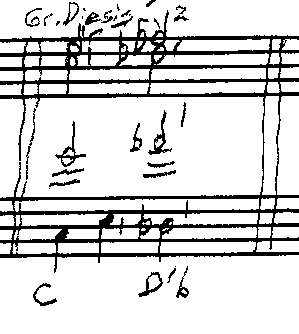Next Page: 13/4 – Modal Modulation
Modulation through the Great Diesis
This chapter deals with “deceptive tonicizations” and some interesting modulations or key changes. The strangest one is below, in this example.
The most interesting 12-eq comma is the Great Diesis, and modulation combined with a Great Diesis comma has enormous affective power. In 53-eq, the 41-cent leap of the Great Diesis is well approximated by a two-step move, say, from E1 to F2b. Here is the relevant part of the lattice for this modulation:
Figure 13-3b Great Diesis and modulation
. E1
. |
. C – G
. |
.D1b — A1b
. |
. F2b
Now let’s do a sudden modulation from C Major to D1b Minor:
C – E1 – G to D1b – F2b – A1b Figure 13-3b with sound [bass line C e1 D1b]
I encourage you to also play this modulation on the piano (the E and the Fb on the piano are of course the same note, which makes this modulation palatable). However, the only note these two keys have “in common” in 53-eq are E1 and F2b, the comma of the Great Diesis in 12-eq. In Johnny Reinhard’s notation, that’s E-21 to E +24. We’re taking a 45-cent microtonal jump, almost a quarter-tone away! In my example above, I’ve put the E1 and F2b right on top so everyone can hear it. At first, you may think it’s closer to a half-step, like Eb to E, but it actually is closer to a quarter-tone. It may take some time for our collective ears to decide if this is even a valid harmonic leap in 53-eq. In 12-eq, the E remains the constant pitch holding these two distantly-related chords together. Play it on the piano; it sounds mysterious but acceptable to the ear. We’ve heard this kind of modulation in classical music for over 130 years now. But with the 45-cent microtonal leap now made obvious in 53-eq, there are no notes in common between the two chords at all. This harmonic leap can be evoked in 12-eq, but how much more intense or even jarring it is when you can hear it for exactly what it is! I’m not sure it works very well in 53-eq. As I’ve mentioned before, it is also possible to hide the E1 – F2b transition in a middle voice where the transition is less obvious. It can work better if the transition is “buried” in a middle voice and maybe with a little vibrato or glissando thrown in. Check out pages 424-425 of Mathieu’s Harmonic Experience for a more detailed description of these modulations with commas.
If you would like to learn much more about this chapter, “Deceptive Tonicizations and Modulations” in 53-equal tunings, you can buy the entire book, The Grand Unified Theory of Music, in pdf form for $25 with hundreds of embedded musical examples of scales and chords from all over the world.
A free introduction to what The Grand Unified Theory of Music offers is on this website and includes both text and a few musical examples from each webpage. If you would like to learn more about this chapter and the full contents of this entire e-book, you can buy The Grand Unified Theory of Music for $25, with hundreds of embedded musical examples of scales and chords from all over the world — and ideas for how to set up your computer system —
HERE.
You’ll get a personalized password you can use to see the entire e-book. Inside the full book, you will also get a link to the complete pdf file of this e-book, which you can read on your Kindle or similar device. The links to the hundreds of mp3 sound files – the same ones you can hear on the website — will also be included. This is “Version 1.0” of The Grand Unified Theory of Music. Because it is an e-book, additions, corrections and improvements in the sound may be added at any time. The Grand Unified Theory of Music is Copyright © 2018 by Christopher Mohr. All rights reserved.
One person per password. Sharing this password with others is a violation of copyright. Do not allow others to use your password or link to the pdf file!

